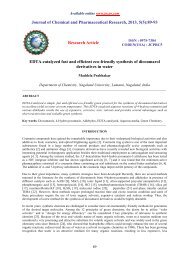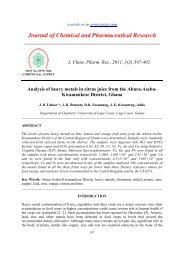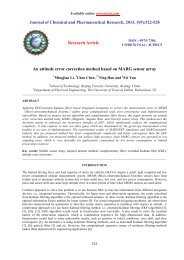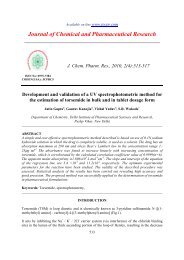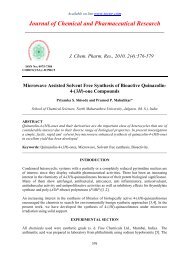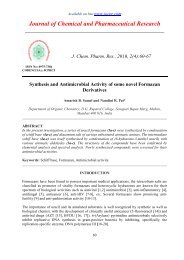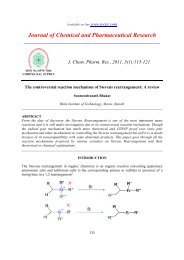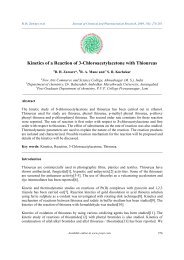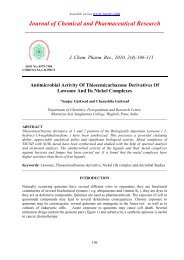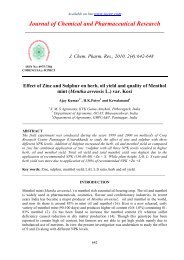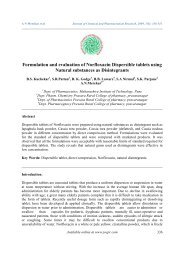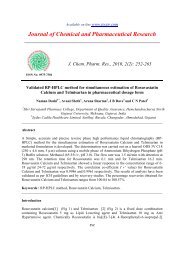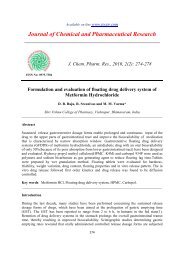Three analytical methods for determination of Epinastine ...
Three analytical methods for determination of Epinastine ...
Three analytical methods for determination of Epinastine ...
You also want an ePaper? Increase the reach of your titles
YUMPU automatically turns print PDFs into web optimized ePapers that Google loves.
Ramzia I. El-Bagary et al J. Chem. Pharm. Res., 2012, 4(2):1361-1369______________________________________________________________________________Fig.(2)Absorption spectra <strong>of</strong> EPH in methanol (20 µg.ml -1 ) ( ______), CAA solution in aceotnitrile (360 µg.ml -1 ) (--------) , and CT complex in methanol-acetonitrile mixture (……….)..The proposed scheme <strong>of</strong> reaction is as follows.Fig.(3): The proposed scheme <strong>of</strong> reaction .The choice <strong>of</strong> solvent, the stability <strong>of</strong> the complexes <strong>for</strong>med and other various experimental parameters wereinvestigated. The stoichiometry <strong>of</strong> the reaction was studied by Job's method <strong>of</strong> continuous variation [8] and it wasrevealed that the interaction occurs in the mole ratio <strong>of</strong> 1:4 (donor: acceptor).CAA solution in various solvents failed to give quantitative results. However, CAA in acetonitrile reactedstoichiometrically <strong>for</strong>ming a purple chloranilic acid radical anion. Acetonitrile proved to be the most suitablediluting solvent as it gives good solvating capacity <strong>for</strong> CAA, and gives the highest yield <strong>of</strong> the radical anion. Othersolvents such as chloro<strong>for</strong>m, 2-propanol, methanol, ethanol were tried and found to be not suitable, because thecomplex <strong>for</strong>med in these solvents either had low absorbance or was precipitated on dilution. The optimum volumeratio <strong>of</strong> drug: reagent <strong>for</strong> complete reaction was found to be 1:6. The reaction between the drug and CAA inacetonitrile was instantaneous and the product remained stable <strong>for</strong> at least 30 minutes. The optimized parameters arelisted in Table (1).3.3. For HPLC method:HPLC has become a widely used tool <strong>for</strong> the routine analysis and separation <strong>of</strong> drugs either alone in pure <strong>for</strong>m [9],or in admixture with other drugs [10,11] or degradation products [11-13] and in pharmaceutical <strong>for</strong>mulations [9-13].Different types <strong>of</strong> stationary phase columns such as C8 and C18 columns with different dimensions and particlesizes were tried <strong>for</strong> example, Agilent C8 zorbax, Agilent C18 zorbax, Agilent C8 Eclipse and Agilent C18 Eclipsecolumns, to obtain the best stationary-mobile phase match. It was clearly found that C18 Lichrocart showed the mostsuitable resolution <strong>for</strong> quantification <strong>of</strong> EPH and its internal standard.Different mobile phases with different buffers and organic modifiers including acetonitrile and methanol have beentested <strong>for</strong> optimizing the HPLC separation. The mobile phase selection was based on peak parameters (symmetry,tailing), run time, ease <strong>of</strong> preparation and cost. It was found that the mobile phase consisting <strong>of</strong> 0.1M ammoniumacetate: acetonitrile in the ratio <strong>of</strong> 60:40 flowing at 1ml/min was quite satisfactory <strong>for</strong> the good resolution and<strong>determination</strong> <strong>of</strong> the studied drug in the presence <strong>of</strong> the internal standard. Any decrease in the ratio <strong>of</strong> ammoniumacetate buffer or increase in flow rate leads to bad resolution between peaks.1365



